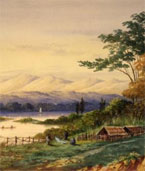Fulbright Scholar Matthew Stott in Yellowstone
New Zealand Fulbright scholar microbiologist Matthew Stott, 41, is spending four months studying microbes that live under extreme conditions in Yellowstone National Park’s geothermal hot springs.
Stott’s fieldwork takes him to places where the water can be near-boiling with acidity levels varying between battery acid and ammonia base. He carries a meter that alerts him if the concentration of poisonous gases in the air is too great, and he always has to watch his footing.
“You can recognise the ground when it’s rubbish and you don’t want to go near it,” Stott said.
Stott’s Fulbright project will compare the microorganisms living in Yellowstone’s geothermal springs to those of the Taupo Volcanic Zone.
“I’m interested in the geothermally heated soils and the bacteria that make a living in them,” Stott said, “how they interact with their environment, how they grow, why they grow where they do and what sort of conditions help them grow.”
“In microbiology, you assume all microbes are everywhere and that environment is the main selecting factor,” he said. “So the idea is if you have two identical hot springs on opposite sides of the world, they should have the same microbiology. In reality, they don’t. My hypothesis is that while the microbiology won’t be the same, the organisms might be expressing the same genes.”
In other words, he’s looking at how microbes on opposite sides of the planet have dealt in similar environments by finding unique evolutionary pathways to survival.
When he returns to New Zealand in December, Stott will continue work on a project to look at the chemistry and microbial diversity of hot springs in Taupo, a project known as One Thousand Springs.
Original article by Michael Becker, Montana State University News Service, October 16, 2016.
Photo by Adrian Sanchez-Gonzalez.















